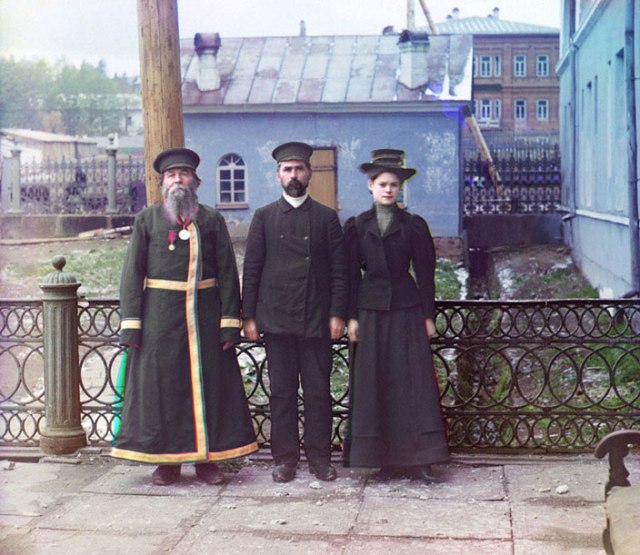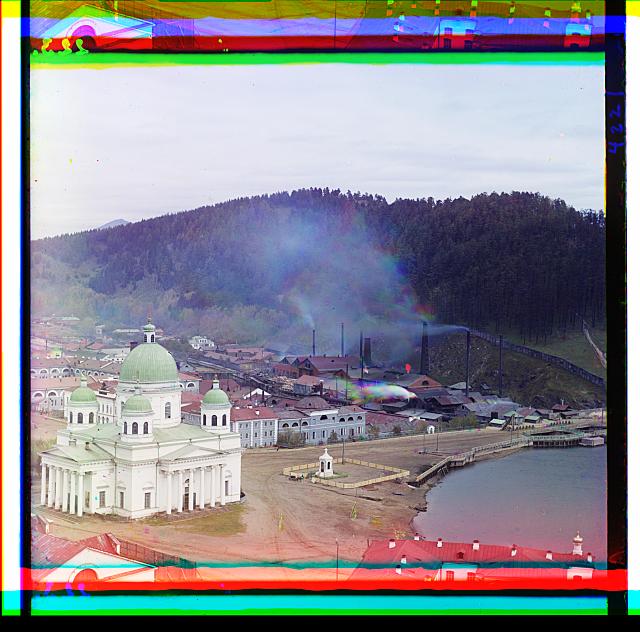
From 1909 to 1915 Sergei Mikhailovich Prokudin-Gorskii embarked on a journey commissioned by Tsar Nicholas II to capture the Russian empire. With his innovative technique for capturing colored images, Prokudin-Gorskii was able to preserve a world that was beginning to change. In this particular photo, called Three Generations, Prokudin-Gorskii was able to capture a cultural shift by studying the different dress and hairstyles worn by A.P. Kalgonov (left) and his son and granddaughter. This photo and many others are available at the Library of Congress.

This photo was taken in the industrial town of Zlatoust in the Ural mountains. Kalgonov’s son and granddaughter worked at the Zlatoust Arms Plant. A view of the plant is shown above in the Prokudin-Gorskii’s photo titled General view of the Zlatoust plant and Trinity Cathedral. The arms plant supplied the Russian military with weapons since the early 1800’s.
The drastic differences in dress and hairstyles between Kalgonov and his son and granddaughter are what makes this photo particularly fascinating. Kalgonov fashions a traditional style whereas his son and granddaughter wear more modern and western styled clothing and hair. This generational shift in style can be attributed to a series of reforms in the mid to late 1800’s which jump-started the modernization and westernization of Russia. Some of these social reforms included emancipating serfs, and allowing non-nobles to receive an education. This led to non-nobles having access to civil and military service. This photo illustrates younger generations disillusioned by traditional Russian culture, who are creating a modernized Russian culture.
While Prokudin-Gorskii was aware of the differences between Kalgonov and his son and granddaughter, he could not predict the revolution which was soon to come. Prokudin-Gorskii completed his mission of capturing Tsar Nicholas II’s empire, but he was also able to capture a world that would soon be lost.
Sources:
Sergei Mikhailovich Prokudin-Gorskii. Three Generations, 1910. Digital color rendering. Prints and Photographs Division, Library of Congress, LC-DIG-ppmsc-03952 (24)
http://www.loc.gov/pictures/item/prk2000000753/
“Russia: A History,” Gregory L. Freeze.

I like how you used the second Prokudin-Gorskii photo to give more context on the first one! I think both photos are really interesting, and show the tension that accompanied all the changes that were happening in Russia right before the revolution. I also like how you mentioned how political measures, such as reforms at the time, coexisted with the social changes at the time.
LikeLike
Kathryn, I thought your analysis of Gorskii’s “Three Generations” was magnificently done. I like how you not only discussed the fashion styles and differences, but also gave an explanation of how and why the fashion changed over the three generations, discussing the impact of modernization and westernization and the “Disillusionment” of the younger generation, which led to the “modernization” you speak of. I also enjoyed that you shared a picture of the Arms plant they worked at and explained its significance in Russian history as well.
LikeLike
Excellent post! You mention that after some reforms and modernizations, non-nobles had access to civil and military service. I think the photograph highlights this quite well if you take a close look at the oldest man’s clothing. It appears as though he has military style medals around his neck and pinned on his chest. This aligns very well with your analysis!
LikeLike
Great point about non-nobles having more access to the civil service as a result of the emancipation! Check out Cameron’s post on the same image: https://thensoviet.wordpress.com/2018/01/18/the-generation-gap-the-visualization-of-western-influence/
LikeLike
I really love this article! You’re writing style is really captivating. I chose the same photograph because I thought the shift was so unique. It’s like watching something change right before your eyes. The history of the arms plant and the role it played in Westernization of this area is so rich and complex but fascinating. It truly shows how even the tiniest kinds of sparks and ignite huge fires!
LikeLike